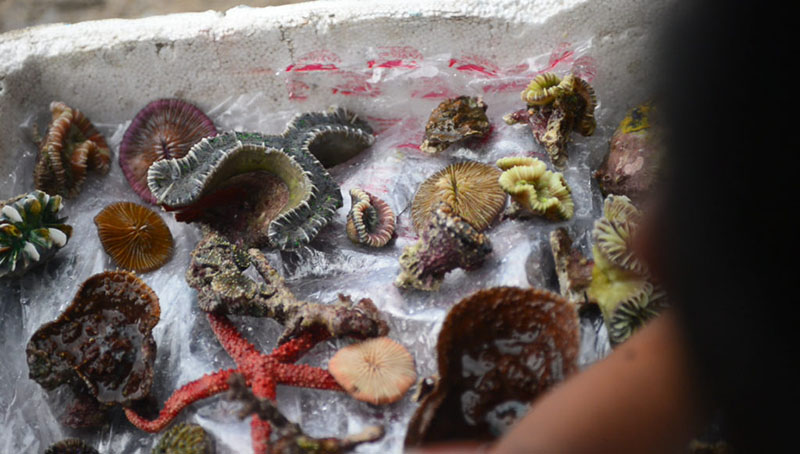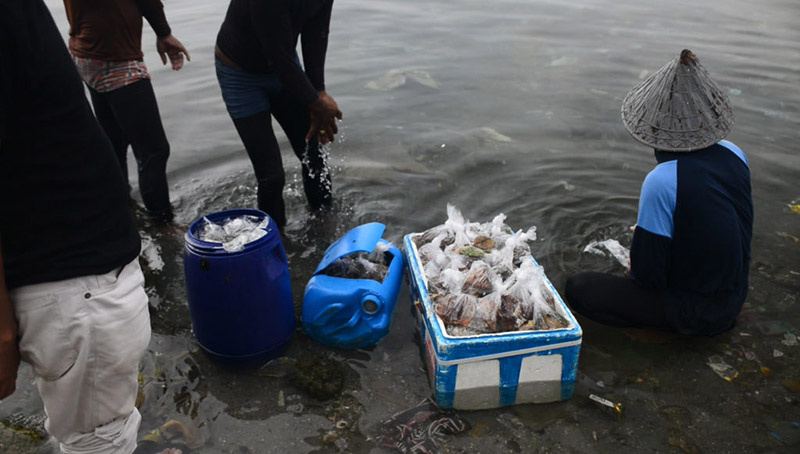Many people panic the first time they are hooked up to an underwater breathing machine; to inhale below the chop of the waves feels like the pinnacle of self-destruction, and sometimes, it is.
The rush of adrenaline can cause novice scuba divers to blow through a whole tank of gas in what feels like minutes, sucking down breath after unassured breath. The deeper you are, the faster the tank empties: at 30 meters, the pressure is equivalent to four of earth’s atmospheres and you need four times the air to fill your lungs. For every 10 meters, add the weight of another sky.
Diving has long been associated with the expansion of human agency: bodies of all varieties can be easily outfitted for the life aquatic. In 1942, Emile Gagnan and Jacques-Yves Cousteau developed the world’s first real Self Contained Underwater Breathing Apparatus (SCUBA). In English, they called it the “aqualung,” a new machinic organ which promised to make humans into bonafide sea cyborgs. Mid-20th century pop culture obsessions with military frogmen drove home the extent to which diving equipment and other emerging technologies seemed to generate new kinds of human hybrids. With the addition of the aqualung, the limits of the human body could be exceeded, reaching unseen depths.
But the cultural association of diving as an enhancer of mobility and agency conceals the fact that not all diving feels like freedom. A radically uneven distribution of safe, reliable diving equipment means that many, if not most commercial divers in the global south, such as marine product collectors in Indonesia, are forced to shoulder immense bodily risk to keep production costs low and ensure supply chain profitability.

Live coral being sorted and priced after collection. Photo: Joseph Klein
I started getting serious about dive training when I began to study the Indonesian live coral trade for my dissertation. As the epicenter of global marine biodiversity and home to more coral reef than any country on earth, Indonesia is both ranked among the most revered locations for recreational diving, as well as the world’s leading exporter of luxury marine products, including the coral itself. Every year Indonesia exports over 1 million live corals to supply the transnational saltwater aquarium industry. Most of these corals are wild collected from eastern Indonesia by teams of divers employed by bosses or patrons who bankroll collecting expeditions.
Before the invention of diving equipment, marine product collectors relied on masterful feats of breath-hold diving in their search for pearls, sea cucumbers, and other riches. One 19th century account describes an elite diver in Sulu who could stay underwater “so long as is required to make a dish of chocolate” (quoted in Warren 1981: 73). Yet even the most skilled divers measured themselves in mere minutes. Then, in the late 20th century, everything changed.
Although scuba gear had been in commercial use in Indonesia since the 1960s, in the 1980s these rigs were ditched in favor of a newer, cheaper alternative: the compressor (Fougeres 2011). The idea was simple: rather than carrying a limited supply of air in a tank, why not use a boat-mounted compressor to pump air directly to divers underwater? Not only was the compressor much cheaper than scuba gear, but it could be shared by many divers at once, and seemed to allow for longer, deeper dives since the air supply had no limits.
With the compressor, cutting corners to further reduce capital outlays was easy. While dive-grade setups were available, most bosses invested in industrial air compressors (the kind used to inflate truck tires) crudely lashed to cheap garden hoses. Divers would simply strap on a few kilos of lead, clench the bare hose between their teeth, and wind the thin tubing around their waist or neck so as not to lose hold on the breath of life. The overzealous delivery of the compressors would often blast violent jets of air into divers’ mouths, and sipping from the deluge required care and skill. On the other hand, if the compressor was too weak to deliver enough pressure, your chest would seize with painful contractions. And if the compressor failed entirely, the whole team of divers was stuck.
But the same factors that made compressor diving extremely dangerous were those that made it so commercially appealing: the compressor dramatically expanded the time-space of humans underwater. Unlike scuba or breath-hold diving, compressor diving is not time-limited by the air supply in a diver’s tank or lungs. With the compressor, minutes become hours, and depth limits fall away. The reef becomes a new frontier. On a compressor, divers can spend hours searching for the perfect corals, the largest pearls, or juiciest lobster. Compressors made it easy to use cyanide to capture live fish. Some users even developed elaborate team based net fishing techniques, a practice featured prominently in a 2011 BBC documentary; in contrast to the aqualung, the narrator describes the compressor as “a failing heart pumping through clogged arteries.”
This expansion of underwater time-space has come at perilously high cost to coral workers, who have precious little access to the technical knowledge or simple devices which would allow them to time their dives and limit their depths to avoid the perils of decompression sickness (“the bends”). Without these tools, even highly experienced divers risk injury. In her work with compressor divers in the Dominican Republic, my colleague Kyrstin Mallon Andrews (2016) recounts how diving fishermen attempt to read depth through subtle changes in the color of seawater; crystal clear seas often appear deceptively shallow, luring even experienced divers beyond the limits of a safe dive. Indeed, the risk of severe, paralyzing injury or death increases with time and especially with depth—limits which compressors are specifically employed to circumvent.

Returned divers cleaning live coral before sorting and pricing. Photo: Joseph Klein
The theme of bodies extended by machines and human agency boosted by cyborg assemblages has played a key role in anthropological theorizations of science and technology. The figure of the cyborg has often appeared liberatory, signaling the eclipsing of essentialism and biotic determinism (Haraway 1991). In the ocean, submarines and scuba gear seem to transcend the limited abilities of individual human bodies (Helmreich 2007). Technology offers the chance to become ocean, become marine-mammal, become cyborg.
However, the unspoken nag of many a cyborg dream is the unequal and uneven access to technology. Access to different tools and technologies with which to extend, remake or enhance one’s body remains a question of class, citizenship, race, gender, and ability—the intersectional differences the cyborg seeks to transcend (a problem analyzed in depth by Jasbir Puar in a 2012 essay). This is not a new insight: for decades dependency theorists and critical development studies scholars emphasized the skewed distribution of technology as a primary driver of uneven development and exploitation (e.g. Galleano 1973). Expensive diving equipment which meets basic safety requirements is not compatible with a supply chain model reliant on cheap labor. The modest financial risk eschewed by bosses becomes bodily risk for divers.
Divers in Indonesia, mostly young men, are often aware of the risks of hooking up to the compressor. But in remote coastal areas with few ways to make a living, they may have little choice. Moreover, because compressors, boats, and other equipment require significant initial capital investment, dive teams are often indebted to a boss or patron, compelling them to dive to recoup their funds (see Radjawali 2012). These circumstances are only exacerbated by the death of shallow, near shore coral reefs, which previously supported subsistence fishing. Anthropogenic coral reef decline has further eroded diver’s options and opportunities, a loss for which no amount of machine enhanced mobility can compensate.
***
In recent years campaigns to regulate or ban the use of diving compressors have spread across Indonesia. In 2016, I spoke to a village leader on a small island near the city of Makassar, a man who used to dive for sea cucumber and coral when he was younger. He and the rest of the island community knew well the extreme risks involved with compressor diving, having witnessed it visit injury and death on young divers for decades. Yet he saw the economic risk of lost livelihoods and incomes as far more dangerous. The island’s own nearshore fringing reef had been decimated, and local coral collectors now traveled up to four hours by boat each way to find a suitable collecting spot, accessible only with diving gear. “If they ban the compressor, how will we live? Here, the compressor is our heart.”
Like the aqualung and other mechanical organs, the compressor-as-heart tries to push back at the limits of the body, extending what is possible for human interactions with the sea. But the compressor compels divers to exceed their own limits, diving longer and deeper to make up for the rampant loss of coral reef fisheries. Indeed, the compulsion to use the compressor places coral divers in a position of extreme economic and bodily risk as they work to stay afloat at a time when environmental collapse seems to have no limits.
References
Fougères, Dorian. 2011. Aquarian Capitalism and Transition in Indonesia. VDM Verlag.
Galeano, Eduardo. 1973. Open Veins of Latin America: Five Centuries of the Pillage of a Continent. NYU Press.
Haraway, Donna. 1991. “A Cyborg Manifesto.” in Simians, Cyborgs, and Women: The Reinvention of Nature. Routledge.
Helmreich, Stefan. 2007. “An Anthropologist Underwater: Immersive Soundscapes, Submarine Cyborgs, and Transductive Ethnography.” American Ethnologist 34 (4): 621–41.
Mallon Andrews, Kyrstin. 2016. “The Color of Seawater: Borderwaters in the Domincan Republic.” Presented at 2016 UCSC Graduate Conference: Shapes, Colors, Contours.
Puar, Jasbir K. 2012. “‘I Would Rather Be a Cyborg than a Goddess’: Becoming-Intersectional in Assemblage Theory.” philoSOPHIA 2 (1): 49–66.
Radjawali, Irendra. 2012. “Social Networks and the Live Reef Food Fish Trade: Examining Sustainability.” Journal of Indonesian Social Sciences and Humanities 4: 67–102.
Warren, James Francis. 1981. The Sulu Zone, 1768-1898: The Dynamics of External Trade, Slavery, and Ethnicity in the Transformation of a Southeast Asian Maritime State. NUS Press.
